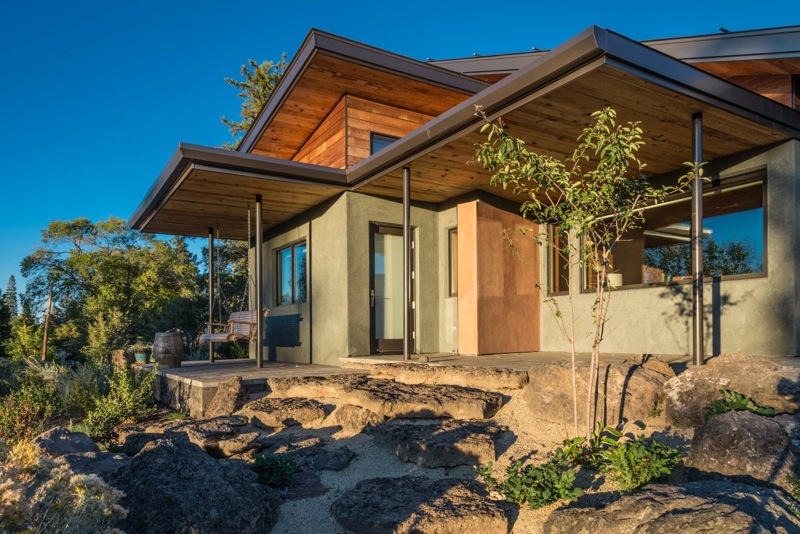A new home in Bend, Oregon - where we're located - has officially been the first single family home in the country to meet the rigorous Living Building Challenge (LBC) standards. Going far beyond LEED Platinum, the LBC standards are effectively the gold standards of green building.
The Living Building Challenge (LBC) is a set of rigorous standards designed to be at the forefront of technology and green building innovation. The LBC has been set up to push development of these building technologies in the hope that they will become mainstream and cost-effective in the near future. Whereas LEED standards attempt to slowly bring mainstream buildings towards a greener composition, LBC attempts to dramatically push innovation for a very small number of structures, becoming an exercises in envelope-pushing engineering, architecture, and design.
This house - named Desert Rain - must be a net producer of energy and water, and cannot rely on any outside sewer services. Using solar and rainwater collection, the structure is completely self sustaining, without any impact on the environment. "Greywater" from showers and sinks is naturally filtered under the house without the use of chemicals, essentially using natural permeation to clean and recycle water. To cut down on the impact of material transport, all materials must come from within 1,500 miles, one-third of which must originate from within 300 miles of the structure. Stucco and interior walls were made from a local combination of sand, lime, and clay, avoiding drywall and other manufactured products.
As one would expect, the unorthodox building process for this 5,000 sqft house did come at a high price. Totalling $3.48 million, Desert Rain boasts a $638/sqft cost. For now, Desert Rain exists as an monument of what is possible, and what will become the new normal decades from now. To learn more about the Desert Rain project, check out OPB's website here.
The gals at Builders Site Protection are here to help you. This blog is our attempt to keep you informed on Surface Protection, Dust Control and Lead Containment updates. We also want to keep you posted on general industry discussions, trade shows and issues facing contractors and builders in the U.S.
Thursday, January 26, 2017
Thursday, January 19, 2017
We've Updated & Improved Our Carpet, Floor, and Countertop Films
Drawing upon years of feedback from builders, commercial and residential alike, we have worked with a new manufacturer to improve our popular line of films. The new films feature an adhesive that initially sticks better than the old formulation, and also peels easily and more cleanly after the film has been used.
Prices for the new and improved film have remained unchanged, though sizing is a bit different. Visit the films page of our website to see the new films. As always, if you have any questions, comments, or concerns regarding any of our products, email us at sales@buildsitepro.com, or call us at 541-633-7793.
Prices for the new and improved film have remained unchanged, though sizing is a bit different. Visit the films page of our website to see the new films. As always, if you have any questions, comments, or concerns regarding any of our products, email us at sales@buildsitepro.com, or call us at 541-633-7793.
Friday, January 13, 2017
We're Excited To Be Involved With the Wilshire Grand Hotel Project In L.A.
 |
| Wilshire Grand Topping Out |
It's always fun to be involved in the construction of a remarkable building, and we look forward to seeing it next time we're working down in Los Angeles.
To learn more about UV Threshold Tape, or any other product we offer, please visit www.buildsitepro.com or email us at sales@buildsitepro.com.
Wednesday, January 4, 2017
2017's Construction Forecast Looks Encouraging
New year, new project starts. A lot of new project starts. Construction projects are expected to increase 5% in 2017, which is a welcome development as 2016's new starts lagged sorely behind expectations - a measly 1% increase was seen in 2016.
Dodge Data & Analytics also expects to see large gains in single family homebuilding, commercial development, and institutional building. Unfortunately, multifamily development is expected to stagnate, as will utilities construction.
Interestingly, both 2015's and 2016's totals were skewed by only a handful of massive projects that kicked off in 2015, effectively acting as enormous outliers and altering both years. 2017 is expected to be far more "normal" in the sense that totals will not be skewed by a few projects (such as 2015's $9 billion natural gas terminal project in Texas). This is also in part responsible for the decline in energy/utilities related building expected this year. 2015's enormous projects are coming on-line, thus driving down the need for new construction in those industries.
While none of the new projects announced this year will need our products and services for some time, we remain excited about the positive prospects that 2017's project starts may bring. Here's to a great 2017!
Dodge Data & Analytics also expects to see large gains in single family homebuilding, commercial development, and institutional building. Unfortunately, multifamily development is expected to stagnate, as will utilities construction.
Interestingly, both 2015's and 2016's totals were skewed by only a handful of massive projects that kicked off in 2015, effectively acting as enormous outliers and altering both years. 2017 is expected to be far more "normal" in the sense that totals will not be skewed by a few projects (such as 2015's $9 billion natural gas terminal project in Texas). This is also in part responsible for the decline in energy/utilities related building expected this year. 2015's enormous projects are coming on-line, thus driving down the need for new construction in those industries.
While none of the new projects announced this year will need our products and services for some time, we remain excited about the positive prospects that 2017's project starts may bring. Here's to a great 2017!
Subscribe to:
Posts (Atom)

